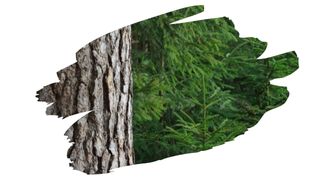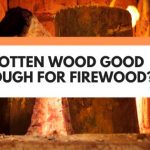Good firewood needs to meet a few key criteria if it is to be safely used in your indoor fireplace.
If wood doesn’t meet these criteria, it is more likely to end up being a fire hazard — especially as it comes to chimney fires.
To put it simply, good firewood needs to burn cleanly, and contain little sap. Plus, it needs to have enough density to it to burn hot enough to be worth burning in the first place.
So, how does Spruce wood stack up against these very simple criteria?
Well, in this post, you’ll learn what makes for clean burning firewood. You’ll also discover what you should look out for, when it comes to fire hazards in firewood.
And keep reading to find out exactly how much energy lightweight Spruce wood can produce.

This post may contain affiliate links to products that we receive a commission for (at no additional cost to you). Learn more here.
What Type Of Wood Generally Burns The Cleanest?
Good firewood shouldn’t contain a lot of sap, and should not come from a poisonous tree species.
Moreover, if you want firewood to burn intensely for a long time, it’s also important that it be dense. That’s because the harder the wood, the more substance it has. And this means that it’ll produce more heat when you burn them.
For this reason, and more, hard high-density woods, such as White Oak and Birch, are excellent options for firewood.
Related Post: Is Acacia Wood A Good Choice For Firewood?
What About Smoke? What Kind Of Firewood Gives Off Very Little Smoke?
When a fire emits lots of smoke, it’s typically because there’s still a lot of moisture in it. And as fire evaporates that moisture, it makes smoke much thicker.
This is why you should always season firewood before using it as fuel. Seasoned wood is simply wood that’s been allowed to dry (after having been freshly logged).
You can learn more about seasoning wood by checking out our post here: How To Season Wood (7 Tips)
What Does Moisture Content Mean (As It Relates To Firewood)? It refers to the amount of moisture saturating a piece of wood. Freshly cut timber has a moisture content of 100 percent. While dry seasoned wood has a moisture content of less than 20 percent.
And What Kind Of Wood Should Not Be Burned In A Fireplace At All?
There are two main types of wood that should never make it onto your fireplace:
A). Avoid Using Poisonous Tree Lumber
Trees containing poisonous sap or toxic compounds, such as the Yew Tree, should not be used as firewood.
Burning these trees can risk releasing those harmful compounds, in the form of soot and fumes.
B). Avoid Using Wood With A Lot Of Sap/Pitch In It
You should be very cautious about burning wood that is tree resin-rich, such as Cedar or Pine.
The tree resins in those particular wood types can gum up chimney flues. And this increases the chances of causing a chimney fire.
Okay. But What About Spruce Wood? Is It Safe To Burn?
Well, Spruce isn’t suitable for an indoor fireplace for two main reasons:
1). Spruce Is Filled With Sap
Spruce timber is saturated with tree sap, just like Cedar and Pine wood.
So, burning this particular wood in an indoor fireplace can increase the risk of starting chimney fires.
2). Spruce Wood Doesn’t Produce That Much Heat
Spruce isn’t a dense timber. Compared to White Oak and Birch wood, there isn’t much to this wood at all. And this is reflected in the amount of heat that Spruce wood produces when burned.
According to its BTU (British Thermal Unit) rating, Spruce wood doesn’t compare to White Oak or Birch.
The British Thermal Unit rating measures how much energy it takes to burn a piece of material. The higher the rating, the more energy it takes to burn. And the more energy it takes, the more heat is produced.
Spruce wood has a BTU rating of just 15.5 BTU. This is barely enough heat to qualify Spruce as kindling, and certainly not enough to properly heat your home. Especially, when you compare it against Birch woods 23.6 BTU rating, and White Oaks whopping 25.7 BTU rating.
But Can You Use Spruce Wood To Heat Up A Home Anyway?
Spruce wood might be a more affordable wood choice option compared to most, when it comes to woodworking. Nonetheless, as a firewood, the high price of it’s fire hazard outweighs the money you could save.
So skip over using Spruce wood altogether. And simply stick to better firewood options, in the form of White Oak, Birch, and even Mulberry Wood.
Related Post: Is Mulberry Wood Any Good For Carving? (Solved!)
To Wrap Up, Here Are The 3 Key Takeaways From This Post…
- 1). Good firewood should be dense, and contain very little tree sap/pitch.
- 2). Low density firewood doesn’t produce much heat. And firewood that’s filled with tree sap can increase the risk of chimney fires.
- 3). Spruce wood contains a lot of tree sap/pitch. And it is a low density wood that doesn’t produce much heat compared to say White Oak or Birch.
References:
Wood Heating | Forestry.usu.edu
Wood Smoke Awareness | EPA.gov
British Thermal Unit | Wikipedia.org



